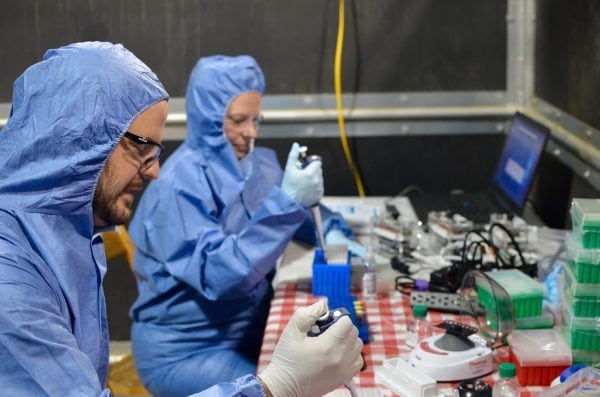CDC’s portable flu testing kit allows for faster, on-site detection of viruses that could cause the next pandemic
CDC researchers have developed a portable flu testing kit that cuts the time needed to sequence and analyze flu viruses of pandemic concern in half.

Feb 6, 2020 – Experts in CDC’s Influenza Division have developed a portable flu laboratory that can sequence the influenza genome and analyze flu A viruses in real-time and on site during an outbreak. The kit, called Mia (Mobile Influenza Analysis), brings influenza sequencing technology out of the laboratory and into the field—cutting the time needed to genetically analyze flu viruses in half and producing real-time, actionable data that can be used in a public health response.
“Mia has the potential to transform influenza surveillance, accelerate vaccine production during an influenza pandemic and greatly enhances CDC’s responsiveness to influenza outbreaks for protecting public health”- John Barnes, PhD, Team Lead, Genomics and Diagnostics, CDC
A recently published articleexternal icon in mSphere details the successful use of Mia to detect and quickly analyze flu A viruses that emerged during an outbreak of flu among pigs in 2018. Using their portable laboratory equipment, the team was able to extract, sequence, and analyze influenza samples from pigs in just 14.5 hours—an impressive improvement over the week required when samples must be sent to a laboratory for examination.
The importance of monitoring flu outbreaks among pigs
Just like human flu viruses, flu viruses that normally circulate among pigs are constantly changing and—although it is very rare—these genetic changes can result in the emergence of entirely new human viruses triggering a pandemic.
When humans are infected with flu viruses that typically infect pigs, these are called “variant virus” infections. Variant viruses are concerning to public health officials for several reasons:
- Flu viruses that infect pigs may be different from human flu viruses, so flu vaccines may not provide protection against them.
- Pigs are susceptible to bird, human, and pig flu viruses—and can be infected with viruses from several different species at the same time. When this happens, it is possible for the genes of these different viruses to combine and create a new flu virus.
- If this new flu virus spreads to people and can be easily transmitted from person to person, a flu pandemic can occur.
During any potential outbreak time is of the essence. For flu, the sooner researchers can understand the genetic composition of the emergent viruses, the sooner prevention and control measures can begin, including the development of a vaccine. Barnes’ team estimates that had the viruses they detected caused a flu pandemic, their proactive surveillance and the time saved by using Mia would have provided an 8-week advantage for vaccine manufacturing.
The success of Mia’s use in the field at the site of a flu outbreak paves the way for future progress toward the decentralization of flu surveillance. Real-time, on-site analysis of flu viruses saves time and allows faster public health countermeasures in response to detection of flu viruseses of potential pandemic concern.
